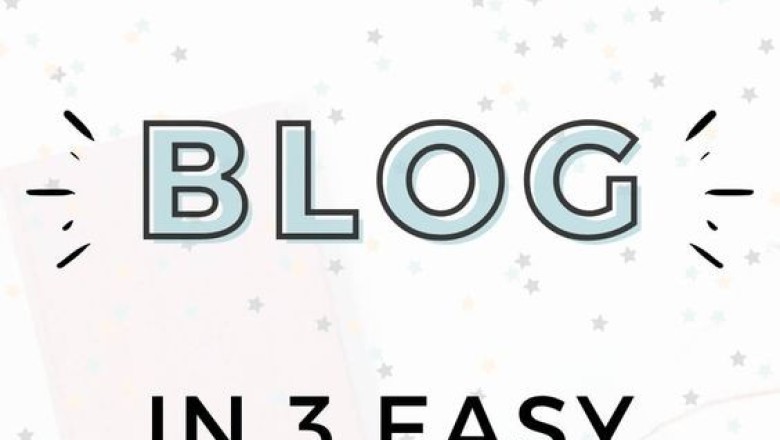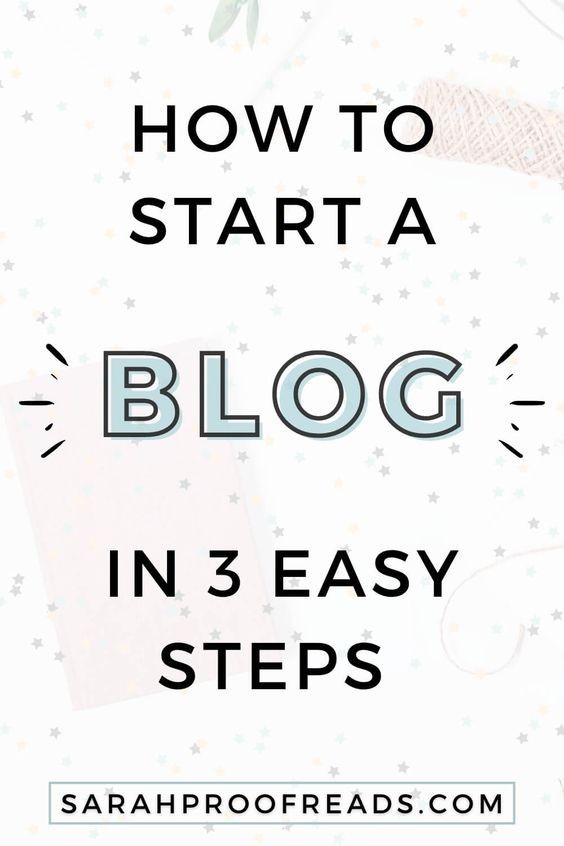
views
How to Start a Blog in 3 Easy Steps
So you’re ready to learn how to start a blog. It’s such a big step, and I’m super excited for you!
But first off, I want to be totally honest with you.
Starting your blog will be difficult. Many blog posts talk about how it’s super quick and easy, but if you really care about being successful, get the thought of quick and easy out of your head.
There will be times you’ll be banging your head on a wall because you can’t figure something out. You’ll wonder if you’re really cut out for this.
But I know you are! If you have the passion and drive to fully commit yourself to your blog, I know you can be successful.
And don’t worry! You don’t have to be super tech-savvy either. Many successful bloggers aren’t, and that’s okay!
There’s a learning curve, but you’ll get the hang of it.
And it’ll be so worth it!
So let’s get started!
1. Decide on your niche and name.
Before you do anything else, you need to figure out what you’ll be blogging about!
To get your brain working, here are a couple of popular blog niches that will be easiest to drive traffic to and monetize:
- Personal finance / making money
- DIY
- Parenting
- Travel
- Lifestyle
- Beauty/fashion
- Blogging (yep, blogging about blogging is popular!)
- Business
- Food
- Health/fitness
Did any of those speak to you?
Even if not, here are a couple more ways to decide!
You first need to be passionate about your niche.
Blogging is hard. And if you’re blogging about something you don’t truly love, the fire will die down really quick.
Think about what you love and are passionate about, and go from there!
Now think about what skills you have.
Take something you’re passionate about and combine it with your skills in that field, and you’ll be unstoppable.
To start a blog on a particular topic, you should at least have a little authority in it.
But don’t mistake that as needing to be an expert in your niche.
For example, if you were to start a DIY blog, you should have at least done some DIY before.
Make sure you have some experience and can present yourself as an authority, even if you wouldn’t consider yourself an expert.
The beauty of blogging is that you learn as you go. Being passionate about your topic is so much more important than being good at.
Have you ever taught a lesson and found that you learned more teaching it than you would’ve if you’d just been one of the listeners?
The same goes for blogging. When I write a post, I start with what I know, and then I do some additional research on it so that I cover everything I need.
To sum up, focus most on what you’re passionate about, but make sure you at least have a little experience or authority on the topic.
And if you don’t feel that you do, just do some research on it!
Don’t forget about SEO!
Assuming you haven’t yet started your blog, SEO is probably a totally foreign word to you.
SEO stands for search engine optimization. In short, it’s the ability for your website to rank high on search engines (like Google and Bing).
When you start working on driving traffic to your blog, your two main traffic sources will probably be Pinterest and SEO.
SEO is a long game (it can take months for Google to fully index you!), so you want to be implementing good SEO from the get-go!
And the way to do that is by narrowing down on your niche.
Many bloggers make the mistake of writing about multiple topics. Unless they’re closely connected, I’d strongly advise against this.
First off, your audience won’t stick with you. If they want to learn all your beauty tips, they won’t care about those random posts about how to garden.
And the same goes with Google. When choosing how to rank you, Google looks at your site as a whole.
Google cares about your niche and the authority you have in it.
Using our previous example, if most of your blog is about beauty tips but you have three about gardening, those gardening posts won’t do very well on Google, no matter how well you’ve keyworded them.
So keep your niche narrow, but not so narrow that you might run out of blog post ideas!
Choose a name for your blog.
Okay, so you’ve got your niche figured out. Or at least you’re still narrowing in on it!
Now you want to pick a name.
Here are my three rules of thumb:
- Make sure it’s memorable.
- Keep it short.
- Connect it to your niche.
You don’t want people to forget the name of your blog, and if it’s too long, it’ll also be harder to remember and search for.
And if the name of your blog has nothing to do with your niche, you risk confusing people and possibly ranking lower in search engines.
Not very creative? Blanking on a name?
Ask advice from a blogging Facebook group!
The best thing you can do for your blog is to join a few Facebook groups related to blogging so that you can learn from others, connect, help each other grow, and get advice!
I see people asking for name advice all the time, and the other members in the group love to help come up with names!
Last step? Make sure it’s available! Type it in the box below to check!
2. Choose your website platform and hosting.
Yay, you’ve come up with your niche and name! Now that you know the focus of your blog, it’s time to actually start!
Choosing Your Platform / Site Builder
First off, self-hosting, self-hosting, self-hosting.
Don’t go with Blogger, and don’t go with WordPress.com.
Free options might seem tempting, but all they are is limiting. Customizing them is hard, and it’ll be even harder to drive traffic and monetize.
And don’t make the mistake of thinking that you’ll go with one of these free options and switch over later.
Do your blog a favor and go self-hosted right from the beginning!
Now that that’s settled, you’ve got a few other options.
There are a bunch of different site builders to choose from: You’ve got Shopify, Squarespace, WordPress, Wix, and more.
But let me make this easier for you. Choose WordPress.
All the other options are good and fairly simple to use, but you’ll be much more limited. Self-hosted WordPress is the way to go if you truly want to be successful.
Choosing Your Hosting
Now it’s time to purchase the hosting for your website!
There are many different options to choose from, but for beginner bloggers, I’d recommend Bluehost.
It’s one of the cheapest and most reliable, and their customer service team is really helpful if you ever get stuck!
They also have a 30-day money-back guarantee, so even if you change your mind, no worries!
And if you ever feel the need to switch your hosting down the line, it’s really simple to do, so don’t stress too much about it right now.
3. Choose your theme and plugins.
Ah, so you’ve made it to the WordPress dashboard. Lots of confusing buttons? Yep! We’ve all been there!
Understanding WordPress is like mastering a new language. But whether or not you’re tech-savvy, you’ll get the hang of it!
My biggest advice? Go watch a bunch of YouTube videos on WordPress.
I originally started my website for my proofreading business and because I was taking a proofreading course called Proofread Anywhere (really good course!).
I loved the course, but the section on setting up a website was far too short. It looked like it was incredibly easy, but once I started digging into it, I realized how much more complex it truly was.
But don’t stress! You’ll get the hang of it as you go.
Choosing Your Theme
A theme is the foundation of your blog. This will determine how it looks, so it’s a big decision!
A big decision that I screwed up. And I don’t want you to do what I did!
If anything, go with a premium theme. Don’t use one of the free WordPress options.
I first went with a premium theme, and while I’m sure it would be a great option for many people, it didn’t work for me.
And the reason is because while it was pretty, I was limited. I had to conform to the theme, and as I was designing, I kept wanting to change things I couldn’t change (I mean, I could, but I’m not a coding expert!).
So if you’re a bit of a picky perfectionist like I am, let me introduce you to your lifesaver.
Elementor. Elementor is a plugin with drag-and-drop widgets that will help you build your site exactly how you want it.
Elementor has a free version, though I’d highly recommend paying the $50 yearly for all the features (a no-brainer investment for me!).
My entire site was built with Elementor, and I don’t know how I would’ve been able to do it otherwise!
Click here to do your blog a favor and try out Elementor today!
Choosing Your Plugins
If all of these terms are still a bit confusing to you, let me clear this one up. A plugin is an add-on software (some free and some paid) that will modify your site. For example, Elementor is one of them.
Click the Plugins button inside your WordPress dashboard, and you can easily start scrolling through all your options!
There are a lot of different plugins out there to choose from, and it can be a bit overwhelming.
The first rule of thumb is to not install too many plugins. Plugins are meant to help your site, but if you’re installing too many, your site will go slower.
Not ideal, huh? So make sure to stick to the essentials.
Here’s a list of the best plugins to use on your blog!





















Comments
0 comment